
About UsThe Numismatic Bibliomania Society is a non-profit organization promoting numismatic literature. For more information please see our web site at coinbooks.org SubscriptionsThose wishing to become new E-Sylum subscribers (or wishing to Unsubscribe) can go to the following web page link MembershipThere is a membership application available on the web site Membership Application To join, print the application and return it with your check to the address printed on the application. Membership is only $15 to addresses in the U.S., $20 for First Class mail, and $25 elsewhere. For those without web access, write to: David M. Sundman, Secretary/TreasurerNumismatic Bibliomania
Society AsylumFor Asylum mailing address changes and other membership questions, contact David at this email address: dsundman@LittletonCoin.com SubmissionsTo submit items for publication in The E-Sylum, just Reply to this message, or write to the Editor at this address: whomren@coinlibrary.com
BUY THE BOOK BEFORE THE COINYou won't regret it! |
- WAYNE'S WORDS: THE E-SYLUM JANUARY 20, 2013
- LAKE BOOKS NUMISMATIC LITERATURE SALE CLOSES JANUARY 22, 2013
- SKLOW NUMISMATIC LITERATURE SALE #18 CLOSES FEBRUARY 2, 2013
- KOLBE & FANNING’S 2013 NEW YORK BOOK SALE RESULTS
- ANS LIBRARY ACQUIRES COLLINS AND CLAIN-STEFANELLI ARCHIVES
- NEW BOOK: COINS OF ENGLAND AND THE UNITED KINGDOM 2013
- BOOK REVIEW: THE DRAPED BUST HALF DOLLARS OF 1796-1797
- DICK JOHNSON PROPOSES MAKING RITTENHOUSE STATUE OF MELTED CENTS
- JULES FONROBERT AND THE ARMS OF CALIFORNIA HALF DOLLAR
- COIN COLLECTOR'S JOURNAL ARTICLE ON 1875 COHEN SALE
- MORE ON PINSCRATCH AND FACEPLATES
- NOTES FROM E-SYLUM READERS: JANUARY 20, 2013
- THE NUMISMATIC AND PHILATELIC JOURNAL OF JAPAN
- THE 2009 CALIFORNIA TREASURY WARRANTS
- QUERY: INDEXES TO COIN WORLD AND NUMISMATIC SCRAPBOOK SOUGHT
- QUERY: UNUSUAL 1811-DATED TOKEN INFORMATION SOUGHT
- QUERY: WASHINGTON-LIBERTY BELL CENTENNIAL MEDAL INFO SOUGHT
- HARVEY STACK REMEMBERS HAROLD BAREFORD (PART II)
- ADDITIONAL LABOR EXCHANGE NOTES
- WAYNE'S NUMISMATIC DIARY: JANUARY 20, 2013
- MORE U.S. COINS AT THE BRITISH MUSEUM
- 1880 $1,000 SILVER CERTIFICATE OF DEPOSIT
- SCULPTOR AMY KANN'S OBAMA-BIDEN 2ND INAUGURAL MEDAL
- NATIONAL COLLECTOR’S MINT FINED $750,000 OVER 9/11 "COIN"
- ANA SEEKS PAPERS ON WORLD’S FAIR NUMISMATICS
- HANS VOGLER'S COIN ROLLING MILL
- COUNTERFEIT BANKNOTES CIRCULATE FREELY IN CUBA
- AUSTRALIAN MAN FINDS MASSIVE GOLD NUGGET
- AMERICA'S FIRST BOOKLESS PUBLIC LIBRARY
- PERTH MINT COIN DESIGNER ING ING JONG
- IS THE MAPLE LEAF ON CANADIAN BANKNOTE NORWEGIAN?
- PAKISTAN RUMOR CAUSES RUSH TO BUY OLD ONE RUPEE COINS
- FEATURED WEB PAGE: ORIGINAL HOBO NICKEL SOCIETY
WAYNE'S WORDS: THE E-SYLUM JANUARY 20, 2013

New subscribers this week include Dan Lute, courtesy of John Mutch, Jonny Oneal and Marilyn Reback. Welcome aboard! We have 1,619 email subscribers, plus 209 followers on Facebook.
Although separate from The E-Sylum, I'd like to mention an NBS web site update. We have two new advertisers on the NBS home page. Kolbe-Fanning Numismatic Booksellers are our new Featured Sponsor. Also, the NBS Board has agreed to have short text-based link ads on the site, available to any legitimate hobby-related firm or individual. Our first link ad is for CoinSupplyPlanet.com. Thanks to both firms for their support.
These are one-year arrangements, but are not exclusive - other advertisers are welcome, too. Contact me for rates and other information. Gold, silver and bronze sponsor slots are available, as well as additional link ads.
This week we open with an update from Fred Lake, reports on the Kolbe-Fanning New York book sale, the new edition of Coins of England and my review of Jon Amato's book on the 1796-97 Half Dollars.
A featured topic this week is next: Dick Johnson's Wall Street Journal opinion piece, where he advocates eliminating the U.S. cent and nickel, and also proposes creating a bronze statue of our first Mint Director, David Rittenhouse.
Other topics include favorite Mint Directors, California Treasury Warrants, sculptor Amy Kann's Obama-Biden 2nd inaugural medal, counterfeiting in Cuba and whether the maple leaf on the new Canadian banknote is Canadian or Norwegian.
To learn more about Harold Bareford's high standards, William Sheldon’s personal copy of Early American Cents, the John Eshbach’s collection of Charles Steigerwalt works, Hans Vogler's coin rolling mill, the Arms of California half dollar, coffin tokens and The World's Most Valuable Hobo Nickel, read on. Have a great week, everyone!
Wayne Homren
Editor, The E-Sylum
LAKE BOOKS NUMISMATIC LITERATURE SALE CLOSES JANUARY 22, 2013
A reminder that Lake Books mail-sale of numismatic literature closes on Tuesday, January 22nd at 5:00 PM (EST). Bids may be emailed, faxed, or placed by telephone until that time. Bids received after that time will not be honored.
You can view the catalog at www.lakebooks.com/current.html. If you would like to check on your bidding, a better method of contact is via email. That allows me to get back to you in a more expeditious manner. However, telephone calls are quite welcome.
Lot number H 3 was catalogued in error and does not exist. It was to be the John Adams, "Indian Peace Medals of George III". I apologize for the error.
A prices realized list will appear on our web site within 24 hours of the close of the sale.
Good Luck with your bidding, Fred
Lake Books
6822 22nd Ave. N.
St. Petersburg, FL 33710
727-343-8055 Fax 727-381-6822
SKLOW NUMISMATIC LITERATURE SALE #18 CLOSES FEBRUARY 2, 2013
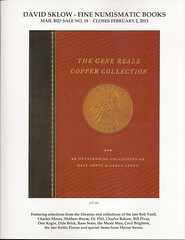 DAVID SKLOW - FINE NUMISMATIC BOOKS
DAVID SKLOW - FINE NUMISMATIC BOOKS
MAIL BID SALE NO. 18
CLOSES FEBRUARY 2, 2013
FEATURED CONSIGNMENTS INCLUDE:
SELECTIONS FROM THE LIBRARY OF THE LATE BOB YUELL HALF CENT EXPERT, CHARLES MOORE’S LIBRARY CONTINUES, THE WORKING LIBRARY OF THE LATE ROLLIE FINNER, SELECTIONS FROM THE RUSS SEAR LIBRARY, SPECIAL ITEMS FROM THE GREAT LIBRARY OF MYRON XENOS AND A FEW SURPRISES!
SOME HIGHLIGHTS:
- Medallic Illustrations of the History of Great Britain and Ireland, 19 volumes, 183 plates. 1904-1911.
- Journal of The Canadian Bankers Association, volumes 1-103, 1893-1996.
- Canadian Antiquarian and numismatic Journal, 1872-1933, 130 of 132 issues.
- Several long runs of the A. N. S. Numismatic Notes and Monographs.
- Empire Guide to U. S. Half Cents 1793-1857, 1962. Heavily annotated personal copy of Bob Yuell.
- American Half Cents The “Little Half Sisters”, 1971. Heavily annotated personal copy of Bob Yuell.
- Super deluxe full morocco, American Half Cents, 1982 by Cohen, inscribed to Bill Weber from Roger Cohen, then to Bob Yuell from Bill Weber.
- Original Frossard 1879, Monograph of U. S. Cents and Half Cents.
- Super deluxe, The Gene Reale Copper Collection, 1995, inscribed to Bob Yuell.
- 1999 reprint [reissue] of the 1963 deluxe Stack’s fixed price list of the Brobston Half Cents.
- Undated reprint [reissue] of the 1969 deluxe inventory of the Showers Half Cents.
- Near mint example of scarce 1922 ANA auction sale by F. C. C. Boyd.
- Runs of Numismatic Literature Dealer catalogs.
- Rare special star note ANA collector currency.
- ANA, First Steam Press Medals, bronze and the scarce limited edition silver.
- Numismatic Scrapbooks from the Grover Criswell library.
- Money art of the late Tim Prusmack.
- Money art of J. S. G. Boggs.
- A long run of Yeoman’s Red Books, first through tenth editions, and all the scarce special editions from the library of Rollie Finner.
- Deluxe combined volume of part one and two of the John J. Ford, Jr. library sales by George Kolbe, one of twenty produced.
- A magnificent example of a Heath counterfeit detector 1880, Bank House ed., Newman 13-BH-2.
- Several hundred 19th Century auction catalogs.
- Runs of early 20th Century auction catalogs.
- David Proskey’s annotated Lyman Low Descriptive Catalogue of Hard Times Tokens, 1886.
- Armand Champa’s personally annotated 1976 Attinelli, heavily noted and color coded.
- Embossed Coin Post Card Album by Alfred Blumel, 1926, very rare.
- Unbound Deluxe, American Numismatic Auctions by Martin Gengerke 1990, 8th edition
- Album of Ancient Coins by Kimball, circa 1880’s, embossed coins.
- Massamore’s Confederate Currency, profusely annotated, the personal copy of E. B. Sterling.
- Mickley’s 1858, Dates of U. S. Coins, and Their Degrees of Rarity.
- Deluxe morocco Wayte Raymond, 1931, Private Gold Coins.
- First edition, 1860, Snowden, A description of Ancient and Modern Coins.
- The United States Mint at Philadelphia, 1903 by James Rankin Young.
Bidders may enter bids by mail, telephone, email or fax. The sale closes at 8pm mountain time, February 2, 2013, however, any bids left on our answering machines or sent by email or fax on or before midnight on closing day will be accepted.
The catalog is viewable on our website. Individuals on our mailing list will have already received their catalogs.
DAVID SKLOW – FINE NUMISMATIC BOOKS
P.O. BOX 6321
COLORADO SPRINGS, CO 80934
TEL: (719) 302-5686
FAX: (719) 302-4933
numismaticbooks@aol.com
www.finenumismaticbooks.com
KOLBE & FANNING’S 2013 NEW YORK BOOK SALE RESULTS
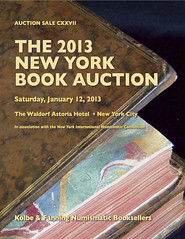 Kolbe & Fanning Numismatic Booksellers held their 2013 New York Book Auction at the Waldorf-Astoria Hotel in New York City on Saturday, January 12, in conjunction with the New York International Numismatic Convention. Composed of 271 lots of high-quality works covering the entire range of numismatics, the sale was notable for including exceptionally important archival materials and unique manuscripts from a variety of sources. Bidding was very strong, with the sale bringing over 140% of the estimated value of the lots.
Kolbe & Fanning Numismatic Booksellers held their 2013 New York Book Auction at the Waldorf-Astoria Hotel in New York City on Saturday, January 12, in conjunction with the New York International Numismatic Convention. Composed of 271 lots of high-quality works covering the entire range of numismatics, the sale was notable for including exceptionally important archival materials and unique manuscripts from a variety of sources. Bidding was very strong, with the sale bringing over 140% of the estimated value of the lots.
Highlights included:
—Unique and highly important materials from the personal archives of Elvira and Vladimir Clain-Stefanelli, including Elvira’s extraordinary notebooks and Vladimir’s extensive archive on the USAOG controversy. In a remarkable coup for numismatic researchers, the notebooks have been acquired by the American Numismatic Society Library, while the USAOG materials were acquired by the library of the American Numismatic Association.
—An exquisitely bound manuscript dated 1720 by Thomas Compton that may well be the earliest substantive work on the entirety of British coinage was also acquired by the ANS Library.
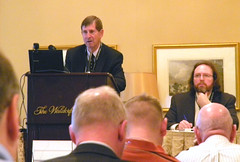 —An extremely important assemblage of materials on the acquisition, sale and subsequent donation to the National Coin Collection of the exceptional collection of Russian coins belonging to Grand Duke Georgii Mikhailovich sold for a remarkable $60,000 hammer to a Russian buyer, who also purchased a photographically illustrated inventory of the Izzy Snyderman collection of Russian coins for $32,500 hammer.
—An extremely important assemblage of materials on the acquisition, sale and subsequent donation to the National Coin Collection of the exceptional collection of Russian coins belonging to Grand Duke Georgii Mikhailovich sold for a remarkable $60,000 hammer to a Russian buyer, who also purchased a photographically illustrated inventory of the Izzy Snyderman collection of Russian coins for $32,500 hammer.
—Tom Virzi’s full 900-page manuscript on the bronze coins of Magna Graecia, an unpublished work of legendary importance, hammered at $5,500.
—A previously unrecorded Geoffrey Charlton Adams sale with two fine photographic plates sold for $4,500 hammer.
—William Sheldon’s personal copy of Early American Cents, with the condition census updated throughout in pencil, presented by the author to specialist John W. Adams, was also acquired for the ANA Library. This, the USAOG archive, and two additional lots were purchased for the ANA Library by longtime ANA supporter Dwight Manley.
—John Eshbach’s exceptional collection of the numismatic works of Charles Steigerwalt brought strong bidding, with the auction sales, fixed-price lists and periodicals combining to bring over $10,000 hammer.
—The ANS Library was the recipient of two important archives of material on early American medals and Washingtonia, both of them purchased for the library by dedicated supporter Tony Terranova.
A PDF version of the catalogue and the full prices realized are available on the Kolbe & Fanning website at www.numislit.com
ANS LIBRARY ACQUIRES COLLINS AND CLAIN-STEFANELLI ARCHIVES
 The American Numismatic Society is pleased to announce some exciting new acquisitions. The Harry W. Bass Jr. Library was able to acquire some important numismatic rarities in the auction of Kolbe and Fanning, conducted on Saturday, January 12, 2013. The acquisition of the following lots was made possible by ANS Fellows John W. Adams, Dan Hamelberg, Anthony Terranova, George Kolbe and ANS Member David Fanning.
The American Numismatic Society is pleased to announce some exciting new acquisitions. The Harry W. Bass Jr. Library was able to acquire some important numismatic rarities in the auction of Kolbe and Fanning, conducted on Saturday, January 12, 2013. The acquisition of the following lots was made possible by ANS Fellows John W. Adams, Dan Hamelberg, Anthony Terranova, George Kolbe and ANS Member David Fanning.
-- Clain-Stefanelli Archives: Vladimir Clain-Stefanelli’s Extensive Manuscript and Typescript Materials, with photographs and additional publications, on the coinage of Callatis. This largely unpublished work is a valuable research tool for Greek numismatic scholars with particular interest in Greek colonies of the Black Sea region.
-- Clain-Stefanelli Archives: Seventy-Seven Binders and Scrapbooks containing thousands of pages of handwritten notes illustrated with clipped coin photos or drawings, including Elvira’s important notebooks on Roman Republican coins. This is another important research tool for scholars focusing on Roman Republican coins. Forty-one small binders hold thousands of pages of handwritten notes, divided by region (from Acarnania to Zankle), along with ten small binders on Roman Republican denarii, among others.
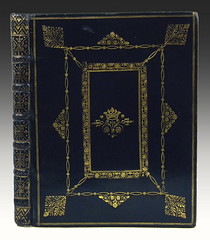 -- Compton, Thomas. Conjectures Upon the British & Saxon Coins &C. Anno D. MDCCXX. By T.C.A.M. &C. 1720. A visually stunning manuscript by Thomas Compton (1698-1761), this unpublished volume may be one of the earliest extant substantial works on British coins ever written.
-- Compton, Thomas. Conjectures Upon the British & Saxon Coins &C. Anno D. MDCCXX. By T.C.A.M. &C. 1720. A visually stunning manuscript by Thomas Compton (1698-1761), this unpublished volume may be one of the earliest extant substantial works on British coins ever written.
-- Clain-Stefanelli, Elvira Eliza and Vladimir. Remarkable assemblage of research materials on American medals and foreign medals relating to America. This includes hundreds of pages of photocopied articles, original photographs, manuscript notes and other research materials. It is an important research tool on early U.S. medals, particularly on the Comitia Americana series.
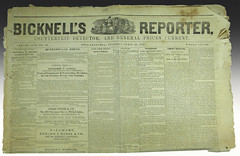 -- Bicknell, Robert T. Bicknell’s Reporter, Counterfeit Detector, and General Prices Current. Philadelphia, April 20, 1847 to February 15, 1848. Forty-two issues covering Vol. XVII, Nos. 40, 42-50 and 52, and Vol. XVIII, Nos. 1-11, 13-27 and 29-32. This was an important acquisition for the library, which previously only had 3 issues of this periodical, none of which were repeated in this grouping.
-- Bicknell, Robert T. Bicknell’s Reporter, Counterfeit Detector, and General Prices Current. Philadelphia, April 20, 1847 to February 15, 1848. Forty-two issues covering Vol. XVII, Nos. 40, 42-50 and 52, and Vol. XVIII, Nos. 1-11, 13-27 and 29-32. This was an important acquisition for the library, which previously only had 3 issues of this periodical, none of which were repeated in this grouping.
-- Collins, Jack, and Robert J. Myers. The Jack Collins Archives on Washingtonia. South Gate and New York, late 1980s through 1996. This includes various boxes of archival materials, including manuscript, typescript and printed text descriptions by Jack Collins, 133 glassine envelopes with several prints each, and three boxes of black and white photographic negatives depicting Washington medals, tokens, and coins, among numerous other materials.
Elizabeth Hahn, Francis D. Campbell Librarian of the Society, said after the sale: “We are most grateful to all our friends, who made these acquisitions possible. Our Library is being used by more and more readers, and we are thrilled to be able to add books and manuscripts in the ancient, early modern, US and medals areas.
NEW BOOK: COINS OF ENGLAND AND THE UNITED KINGDOM 2013
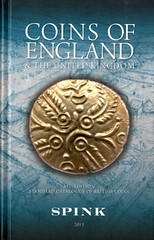 Coins of England and the United Kingdom remains the only single-volume reference work which features every major coin type from Celtic to the present day with accurate market values for every coin type listed. It is an essential guide for beginners, serious numismatists and anyone interested in British Coinage. As with every new edition, all sections of the catalogue have been carefully checked by the specialists at Spink and the prices of the coins have been updated to reflect current market conditions. The reference numbers used are recognized world-wide and are quoted by all of the leading auction houses and dealers. Price £25.00
Coins of England and the United Kingdom remains the only single-volume reference work which features every major coin type from Celtic to the present day with accurate market values for every coin type listed. It is an essential guide for beginners, serious numismatists and anyone interested in British Coinage. As with every new edition, all sections of the catalogue have been carefully checked by the specialists at Spink and the prices of the coins have been updated to reflect current market conditions. The reference numbers used are recognized world-wide and are quoted by all of the leading auction houses and dealers. Price £25.00
For more information, or to order, see: Coins of England and the United Kingdom 48th Edition 2013 by Skingley, P (www.spink.com/books-publications/book-description.aspx?id=69)
THE BOOK BAZARRE
BOOK REVIEW: THE DRAPED BUST HALF DOLLARS OF 1796-1797
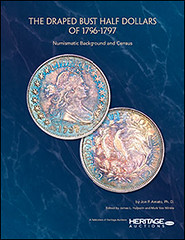 I have a copy of the new book by Jon Amato on the Draped Bust Half Dollars of 1796-1797, and thought I'd share a few impressions. This 338-page softcover volume packs a wealth of information about this short-lived series. The product of years of work, the book is a handy compilation of images and pedigree chains. But "compilation" hardly describes the mountain of work that went into the research for the book. Like an iceberg, the finished book is only the tip - the part we can see and hold in our hands as a result of the author's monumental effort.
I have a copy of the new book by Jon Amato on the Draped Bust Half Dollars of 1796-1797, and thought I'd share a few impressions. This 338-page softcover volume packs a wealth of information about this short-lived series. The product of years of work, the book is a handy compilation of images and pedigree chains. But "compilation" hardly describes the mountain of work that went into the research for the book. Like an iceberg, the finished book is only the tip - the part we can see and hold in our hands as a result of the author's monumental effort.
In these days of Internet sales and online images, it's tempting to think that one could click their way into authoring such a book, but it takes endless hours of research to determine a provenance - hours and hours of searching through old auction catalogs and images, comparing coin after coin looking for clues that reveal which specimen is which.
Dr. Amato has reviewed countless auction listings and photographic plates, with the help of many people throughout the hobby, including numismatic literature dealers Moulton, Brown, Sklow, Kolbe, Fanning, Davis and Lake. All of the major U.S. auction houses pitched in as well with coin images and descriptions. The American Numismatic Society library was also a great resource in this work. And Bruce Perdue notes that this book is another product of the Central States Numismatic Society's research grants. Kudos to all individuals and organizations involved - see the complete acknowledgements on p7-9.
Each specimen is given its own page and serial number in the book (270 different specimens in total). The coin's grade, Identification Markers, Provenance and prices realized are part of each listing. The Identification Markers are the key diagnostics unique to each specimen; these include wear spots, toning, nicks, rimdings and adjustment marks.
The book begins with a brief overview of the history of the coin. Little is actually known about who set things in motion to create the coin design, but bibliophiles and researchers will recognize several famous names - Mint Directors Rittenhouse and De Saussure, artist Gilbert Stuart and engraver Robert Scot. The rest of the book is organized by Overton variety (Al Overton, Early Half Dollar Die Varieties). Page 23 displays a nice visual chart of the 1796-1797 Half Dollar die marriages. Subsequent pages describe in more detail each Overton variety with close-up images.
Dave Bowers has dubbed the coin "the Holy Grail of U.S. Silver Type Coins", a key to completing the set and a rarity in its own right. The book is a wonderful tribute to an important coin in U.S. numismatic history.
I only have two regrets about the book. First, it seems an oversight that the author's name is not included on the spine, only the publisher (Heritage) and the Heritage web address (ha.com). This is unusual - as I look at the numismatic books on my shelves, it's rare to find one without the author's name.
The other regret, not surprising for a bibliophile, is that the book was produced only in softcover format. A reference work as valuable as this deserves a hardcover format. My review copy was damaged in transit, leaving a nasty bend on the front cover. A hard cover would have better protected it.
Mark Van Winkle adds:
It was our thought from the beginning to produce a few copies hardbound. However, when it came time to actually print it, our Marketing Director disabused us of that notion very quickly. It was prohibitively expensive to print the few dozen copies we wanted. At that point, Jon and everyone involved in the editing and production of the book decided it was better to get the book into print in some form and softbound would be just fine.
Jon sweated over this book for eleven years, knowing all the while as soon as it is published there would be duplications found, coins that should have been included that were not, and new appearances. That is why I think the website is such an important feature. If a collector has a coin that is not included or anyone sees an error or omission, they can list it on the website mentioned in the back of the book. That way a new edition can be printed with up-to-date information either when we run out of the current printing or when there is a critical mass of new and revised information to warrant a new edition.
To access the book's web page, see: www.ha.com/JonAmato
To order, see: https://www.ha.com/c/catalog-orders.zx?catalog=EarlyHalfDollars
To read the earlier E-Sylum article, see: NEW BOOK: THE DRAPED BUST HALF DOLLARS OF 1796-1797 (www.coinbooks.org/esylum_v16n02a03.html)
DICK JOHNSON PROPOSES MAKING RITTENHOUSE STATUE OF MELTED CENTS
A Melted Penny for Your Thoughts
The lowest value coin costs more to make than it's worth. Let's get rid of it—along with the nickel and the quarter.
By D. WAYNE JOHNSON
The Obama administration has officially repudiated the idea of minting a trillion-dollar platinum coin to address some of its fiscal problems. Washington shouldn't stop there. Next to go should be not only the penny but the nickel, too.
Already each penny costs the U.S. government more than a cent to manufacture and distribute, and that cost is only rising without a suitable substitute for the raw materials. The coin has less purchasing power today than the U.S. half-cent coin did when the government abolished it in 1857.
But how to eliminate a coin? There are 150 billion pennies in banks, the cash drawers of retailers, the pockets and purses of citizens, and the jars atop dressers. Françoise R. Velde, chief economist of the Chicago Federal Reserve Bank, suggests the government revalue (or "rebase") all cents to the value of a nickel so that they would circulate side-by-side, both worth five cents. A Treasury proclamation would do the trick at no cost.
This change would cause mini windfalls all over the nation, as 100 pennies in that dresser jar suddenly become worth five dollars, but it would prevent the problem of scrapping all those loose pennies.
Sooner or later, the government should also rebase nickels to the value of dimes, since nickels also cost more to produce than they are worth. A Dallas speculator whom I know (but who wishes to remain anonymous) has already hedged for that event by squirreling away $1 million worth of nickels in a Texas warehouse.
At least the U.S. is lucky that it has only five coin denominations in circulation. Italy struck seven denominations of euro coins in 2002, but by 2012 merchants and the public were throwing away the two lowest ones, deeming them valueless. There is a sixth U.S. coin—the dollar piece—but Americans have largely rejected it. Though Washington has struck 2.38 billion dollar coins since 1979, the bulk (1.2 billion) now reside in Federal Reserve storage.
Fourteen countries have now eliminated their lowest or two lowest coin denominations. All then rounded prices up or down to the value of the nearest coin still in active circulation. "Merchants will always round up, costing more for buyers!" screamed the naysayers. Not so. A 2006 Wake Forest University study of 200,000 convenience-store transactions in the eastern U.S. revealed that the rounding tends to balance out in a year's time.
So what coin denominations should Americans plan for in the long term, as the value of low-denomination coins declines further due to inflation? Keep the dollar as the unit, as well as a 10-cent and 50-cent division of the dollar. That is three coins to keep while eliminating the cent, nickel and quarter.
Then, add five-dollar and 10-dollar coins, and the U.S. would again have five denominations to fill the drawer of every cash register. Stop printing paper currency in these denominations and accrue even more savings, as coins outlast paper 20-to-one in circulation.
Australia made a transition like this in two steps, abolishing its one-cent coin in 1990 and its two-cent coin the following year, melting both to make medals for the 2000 Summer Olympics in Sydney. But it is more efficient to do it all at once—and more considerate to the vending-machine industry, the largest user of coins. Industry spokesmen in the U.S. estimate it could cost up to $3.5 billion to recalibrate all their machines, and they shouldn't be expected to do so twice.
In the plan to eliminate the cent, nickel and quarter, the latter two could be melted and recycled into new denomination coins. But what about all those cents?
Here is where the Treasury deserves great respect. In 1982, it began making cents with a zinc core and copper plating, rather than with a copper-zinc alloy. A gold star award to the Treasury official who made that decision. The brilliant part is that when all those cents are scrapped—those minted before 1982 and those minted since—the result will be a mixed alloy of copper and zinc. Voilà, brass. Add a little virgin copper and you have bronze.
Thus all those cents could be melted and used for bronze statues or bronze bells. But it is tricky to achieve the proper resonance for a perfect bell sound. So I have commissioned a top American sculptor—Elizabeth Jones, former chief engraver of the U.S. Mint—to sculpt a life-size or larger statue of David Rittenhouse, the first director of the U.S. Mint and a prominent astronomer and financial officer for Pennsylvania.
Gathering 23.7 million of those unwanted cents would furnish ample metal for a bronze statue of Rittenhouse to stand in Philadelphia's Rittenhouse Square. The surplus metal would be sold to pay the artist, foundry expenses and other costs. The city of Philadelphia and the state of Pennsylvania would receive a bronze statue at no cost, and Rittenhouse would be honored with the metal from coins created by the Mint he founded in 1792.
The Rittenhouse statue should be reason enough for the Treasury to issue a waiver to its 2006 policy outlawing the melting of pennies. An added bonus are the hundreds or thousands of other bronze statues and bell towers that could go up in other cities across America.
Mr. Johnson is corporate historian of the Medallic Art Company.
A version of this article appeared January 15, 2013, on page A17 in the U.S. edition of The Wall Street Journal, with the headline: A Melted Penny for Your Thoughts.
To read the complete article (subscription required), see: A Melted Penny for Your Thoughts (online.wsj.com/article/SB10001424127887323374504578223484113806430.html)
Dick Johnson adds:
I wrote this on Christmas Day before I attacked a 15-inch stack of books received as Christmas gifts. Three of those books were on Lincoln -- my family knows my love of Lincoln. And even though I propose the abolishment of the Lincoln cent, I am a devotee of collecting the Lincoln cent and an avid admirer of Victor D. Brenner and his coin and medal creations. I have written extensively on Benner and cataloged more than 300 of his artistic creations. (In comparison to Smedley's catalog of 120 Brenner items!)
The original draft of this article was in response to the 2-year 400-page $1.5 million study ordered by the U.S. Treasury. It studied 29 metals as a possible substitute for the U.S. cent. None were found suitable.
Since the Journal editors held the article until the second week of January apparently they felt that study report was no longer timely. Instead they changed the lead paragraph to that stupid trillion dollar platinum coin idea. They must have felt that was more timely.
The original draft was 32 epigraphs (1500 words -- within their requirement for an Op-Ed piece). They edited in half -- to 16 paragraphs, and eliminated every word on that report.
Instead of offering an intelligent plant for revamping our coinage system and the reasons for so doing -- they made it look like I am only an advocate for melting cents. That is only a part of it.
This week, D. Wayne Johnson, historian of the Medallic Art Company, proposed in The Wall Street Journal that the U.S. government get rid of the penny, nickel and quarter. You can't buy a pack of gum with a quarter these days. Pennies and nickels are often just cast into bowls, drawers and jars, useless and unspent.
So Mr. Johnson suggests we round off prices to the nearest 10, and start minting just 10 cent, 50 cent and $1 coins. The dollar coin would replace the bill, which gets worn, wrinkly, and then won't work in vending machines.
It's one of those ideas that sounds sensible every way but politically. And politics is what truly counts.
That's not Larry, Curly and Moe on the penny, nickel and quarter; it's Lincoln, Jefferson and Washington — two founding fathers and the president who saved the Union. Can you imagine any Congress taking those profiles off of coins?
But even if you put those old presidents on new dimes, half-dollars and dollars, you'd have to scrap Franklin D. Roosevelt, John F. Kennedy, and Sacagawea. Half-dollars and dollars aren't used much right now, except by casinos and the Tooth Fairy. But imagine the outcry if Congress proposed removing from our money the president who won World War II, the president who personified youthful vigor, and a woman who helped open the West?
Can you see why when the European Union started minting money, they chose stylized architectural details instead of people?
To listen, or read the complete article, see:
A Thought That's Worth More Than A Penny (Or A Nickel)
(www.npr.org/2013/01/19/169723296/a-thought-thats-worth-more-than
-a-penny-or-a-nickel)
JULES FONROBERT AND THE ARMS OF CALIFORNIA HALF DOLLAR
Regarding last's week's identification of Jules Fonrobert as the "Roberts" bidder in the 1875 Mendes I. Cohen sale, Bob Leonard writes:
What a fine piece of detective work! I would be interested to know whether the Mendes I. Cohen collection included any small California gold (not mentioned in Adams), and if so, whether any was purchased by "Roberts," but I don't have an email address for Dave Stone. I'd like to know the lot numbers (and descriptions, if possible).
I spent a couple of days in the American Numismatic Society library around 2001-2002 when I was researching the 2nd ed. of California Pioneer Fractional Gold, tracing early sales of these pieces in named catalogs, but did not get around to the Cohen sale.
The Arms of California half dollar is slightly controversial because its dies are not shared with any other issue, and its first known appearance is 1877. While this puts it squarely within the correct time period, which extends to 1883, Mike Locke suspected that it may be dated earlier than its issue, and I wondered whether it might not be a fantasy gotten up to sell to the wealthy Fonrobert. I am still anxiously looking for an earlier appearance than 1877.
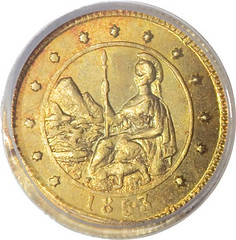
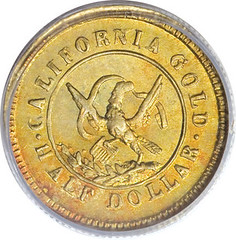
Famous Arms of California BG-435 Round Half MS63 1853 50C Arms of California 50 Cents, BG-435, Low R.5, MS63 PCGS. One of the most famous varieties within the entire California small denomination gold series. The obverse depicts the California state arms, and the reverse emulates loosely emulates the eagle, ribbon, and shield motif used on the Assay Office slugs then in local circulation. Such interesting types would soon belong to the past, since the majority of the Breen-Gillio varieties feature a parade of Liberty, Indian, and wreath types vaguely reminiscent of the Federal gold dollar.
To view the complete lot description, see: 1853 50C Arms of California 50 Cents, BG-435, Low R.5 (coins.ha.com/c/item.zx?saleNo=444&lotIdNo=18001)
To read the earlier E-Sylum article, see: MORE ON JULES FONROBERT (www.coinbooks.org/esylum_v16n02a15.html)
COIN COLLECTOR'S JOURNAL ARTICLE ON 1875 COHEN SALE
Part of Dave Stone and Mark Borckardt's detective work on the Jules Fonrobert collection involved the 1792 pattern disme from the 1875 Cogan sale of the Mendes I. Cohen collection. The disme was lot #378. Rick Stroman writes:
Here is a piece concerning the Cohen Sale from the pages of the Coin Collector's Journal December1875 issue page 3 (actually, the report on the Cohen sale ran from page 3 to 7) .
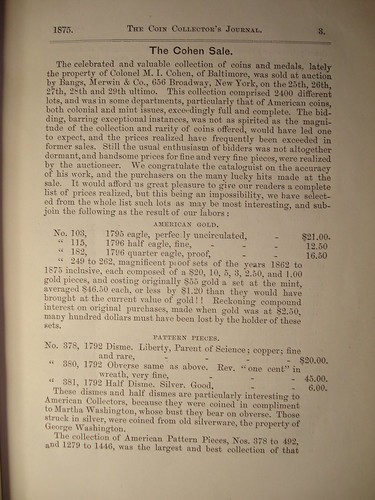
To read the earlier E-Sylum article, see: MORE ON JULES FONROBERT (www.coinbooks.org/esylum_v16n02a15.html)
Mark your calendar!
Tuesday, January 29, 2013
Internet-Only Sale
Selections from the
Steve Tanenbaum Collection
of
1867-1876 Shell Cards
Among the rarest, most interesting, and most significant specialties within 19th century American numismatics are shell cards. These are metal encasements somewhat like encased postage stamps in concept. Most are in the range of 34 to 39 cm, or the size of American double eagles and Liberty Seated dollars. In fact, many of these have these coin motifs. Others have a circular mirror on one side—intended to have the recipient keep the shell card is it remained useful. Otherwise, trade tokens and related exonumia were apt to be discarded.
The other side has the advertisement of a merchant, service, or product. Some of these are in embossed brass, as in the manner of encased postage stamps, while others are printed circular thin cardboard discs, usually in color.
These were a passion for the late Steve Tanenbaum, and he spent over 40 years collecting them—in the process forming the largest such collection ever. Part 2 will be offered in a forthcoming Stack’s Bowers Galleries sale, probably in connection with our official auction for the Whitman Coins & Collectibles Expo in Baltimore in June. As a reality check, the largest other collection known to me is that of the American Numismatic Society and comprises about 100 pieces. A “great collection” of shell cards would be doing well to have as many as 50!
The collection is NOW on line at the Stack’s Bowers Galleries website. Bids are being accepted now and will be until the closing on Monday, January 29. The shell cards are lots 14,000 to 14,104. No comparable offering has taken place in the past century!
As there is no reference book at all on this subject (imagine that!), I am in the process of creating one. It will be color-illustrated, on fine paper, and will have all of the information I can find. I am not ready to announce a publication date (in that way I can’t possibly be late!), but it is about 80% done. A visit to the American Numismatic Society is in the offing so I can capture information on any varieties unknown to me. When the book is ready I or the publisher will make advance announcements. Likely, the press run will be limited.
I invite you to visit the Stack’s Bowers Galleries website, read the introductory material I prepared—about the history and other aspects—contemplate the listings, and bid for any that are of interest. In the meantime, my best wishes to you
![Shell card 232803_01[3]](http://farm9.staticflickr.com/8046/8387158554_2238ecffd4_m.jpg)
![Shell card 232803_02[1]](http://farm9.staticflickr.com/8368/8386073109_b26abb6ebf_m.jpg)
MORE ON PINSCRATCH AND FACEPLATES
Ralf Böpple of Stuttgart / Germany writes:
Dick Johnson describes "hairlines" as scratches in the die that lead to raised lines on the coin, as opposed to "pinscratches" which are depressed lines on a coin (i.e., light scratches).
However, from my first steps in US numismatics on I was informed that hairlines are rather very light scratches on a coin's surface, generally caused by improper cleaning (slight rubbing of the surface).
In this sense, "pinscratches" and "hairlines" are actually the same. The only difference that I could see would be one single light scratch being called a "pinscratch", as opposed to many light scratches from cleaning or other forms of rubbing, mostly parallel, but also going into different directions, being "hairlines".
Raised lines, coming from scratches (not cracks!) in the die, are to my knowledge called "die polishing". If it were only one single line / scratch in the die, I'd call it a "defect die".
"Die cracks" are a different phenomenon altogether and don't leave marks on a coin that resemble scratches, neither depressed nor raised.
To read the earlier E-Sylum article, see: NUMISMATIC VOCABULARY WORDS: PINSCRATCH AND FACEPLATES (www.coinbooks.org/esylum_v16n02a21.html)
NOTES FROM E-SYLUM READERS: JANUARY 20, 2013
Dave Hirt on Fonrobert and Collecting CSA Paper Money
From Budapest Dave Hirt writes:
I am still away from home, but still enjoying The E-Sylum. The posts on Jules Fonrobert the last two weeks were quite interesting to me. He was an amazing collector, almost a Virgil Brand predecessor. I have a nicely bound catalog of his North American collection, which I bought back in 1979 in a Kolbe sale. The coins are meticulously cataloged, even the commonest coin or token is described. However, the catalog is printed on very high acid paper, and the pages tear very easily, so it has to be handled very carefully.
One of the books I brought with me to read is History of Collecting Confederate States of America Paper Money. Although I never have collected Confederate Paper Money, I really have been enjoying it! I echo the words of A. Hudson McDonald who wrote the foreword: "Never had I realized there was such a history of collecting Confederate States of America paper currency". All the evidence was out there. It just took the great job of authors Pierre Fricke and Fred Reed to put it together. A bonus for me is that most of the catalogs mentioned are already in my library. I will have a lot of fun when I return home, pulling my catalogs off the shelf, and comparing them to the ones in the text.
Glad to read that the Kolbe-Fanning NYC sale was such a success. Numismatic literature seems to be off to a great start in this new year!
A John L Riddell Signature
Steve Feller writes:
Attached is my cover image of the signature of John L Riddell. Note the presence of his provisional stamps as well. Click on the image to view a larger version in our Flickr archive.
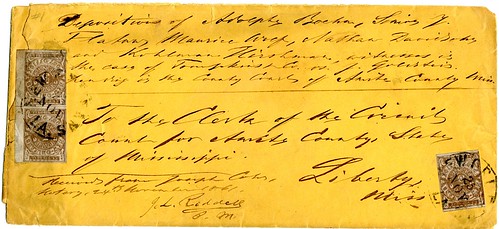
To read an earlier E-Sylum article, see: FROM TEXAS TO THE MOON WITH JOHN LEONARD RIDDELL (www.coinbooks.org/esylum_v15n54a10.html)
Is the eBay 'Coin Die" a Mold for Plastic?
Greg Adams writes:
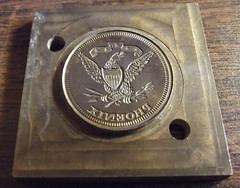 The shape of the "Coin Die" pictured last week doesn’t lend itself to striking anything that requires much pressure. It looks more like half of a mold for plastics (looks to be about the right size to make a marker for a standard size checkers set doesn’t it?)
The shape of the "Coin Die" pictured last week doesn’t lend itself to striking anything that requires much pressure. It looks more like half of a mold for plastics (looks to be about the right size to make a marker for a standard size checkers set doesn’t it?)
To read the earlier E-Sylum article, see: QUERY: WHAT IS THIS EBAY 'MINT DIE'? (www.coinbooks.org/esylum_v16n02a16.html)
On Passing a Counterfeit
Regarding my commentary on the man caught trying to eat fake money, Greg Burns writes:
“Passing a counterfeit”… you’re too funny
To read the earlier E-Sylum article, see: SUSPECT TRIES TO EAT COUNTERFEIT MONEY (www.coinbooks.org/esylum_v16n02a33.html)
On German Hyperinflation
Ron Guth writes:
Regarding David Klinger's display of the Stuttgart inflationary note in the January 13, 2013 E-Sylum, your readers might be interested to know that the German "Billion" means "trillion" in English. Thus, David's "Fuenf Billionen Mark" banknote is actually a 5 Trillion Mark note. As an aside, the German word for billion is milliarde.
The Westphalian coins were issued from 1921 to 1923 in denominations ranging from 50 Pfennig to 1 Billion Mark (remember, that's 1 Trillion). They are all fairly common with the exception of the 1 Billion (1 Trillion) coin and they make a great-looking collection.
Here's a great article about the hyperinflation in Weimar Germany that led to the production of these coins and notes:
WEIMAR: Here's What We Know About The Hyperinflation Horror Story That Haunts Europe Today
(www.businessinsider.com/weimar-the-real-story-of-the-devastating
-collapse-that-haunts-the-eurozone-today-2012-10?op=1)
To read the earlier E-Sylum article, see: INFLATION MONEY AND PROPOSED PLATINUM COIN DESIGNS (www.coinbooks.org/esylum_v16n02a23.html)
George Calvert, the First Lord Baltimore
Tony Hine writes:
Since Sunday's missive showed A Maryland Map medal, I thought your readers might enjoy a reference to Cecil's father George, the first Lord Baltimore.
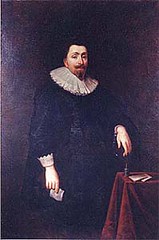 George Calvert, 1st Baron Baltimore, 8th Proprietary Governor of Newfoundland (1579–15 April 1632) was an English politician and colonizer. He achieved domestic political success as a Member of Parliament and later Secretary of State under King James I. He lost much of his political power after his support for a failed marriage alliance between Prince Charles and the Spanish royal family. Rather than continue in politics, he resigned all of his political offices in 1625 except for his position on the Privy Council and declared his Catholicism publicly. He was granted the title of 1st Baron Baltimore in the Irish peerage upon his resignation.
George Calvert, 1st Baron Baltimore, 8th Proprietary Governor of Newfoundland (1579–15 April 1632) was an English politician and colonizer. He achieved domestic political success as a Member of Parliament and later Secretary of State under King James I. He lost much of his political power after his support for a failed marriage alliance between Prince Charles and the Spanish royal family. Rather than continue in politics, he resigned all of his political offices in 1625 except for his position on the Privy Council and declared his Catholicism publicly. He was granted the title of 1st Baron Baltimore in the Irish peerage upon his resignation.
Calvert took an interest in the colonisation of the New World, at first for commercial reasons and later to create a refuge for English Catholics. He became the proprietor of Avalon, the first sustained English settlement on the island of Newfoundland. Discouraged by its climate and the sufferings of the settlers, Calvert looked for a more suitable spot further south and sought a new royal charter to settle the region, which would become the state of Maryland. Calvert died five weeks before the new charter was sealed, leaving the settlement of the Maryland colony to his son Cecilius. His second son Leonard Calvert was the first colonial governor of the Province of Maryland. Historians have long recognized George Calvert as the founder of Maryland, in spirit if not in fact.
To read the complete article, see: George Calvert, 1st Baron Baltimore (en.wikipedia.org/wiki/George_Calvert,_1st_Baron_Baltimore)
To read the earlier E-Sylum article, see: HERITAGE OFFERS THE JOHN W. ADAMS COLLECTION OF BETTS MEDALS (www.coinbooks.org/esylum_v16n02a12.html)
Hobo Nickel Brings Record Price
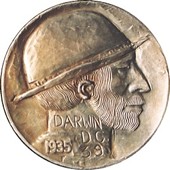 With a winning bid of $22,000 plus a 10 percent buyer’s fee, a Bearded Man/Boxcar hobo nickel done by George Washington “Bo” Hughes dominated the 21st mail and floor bid auction conducted Jan. 12 during a meeting of the Original Hobo Nickel Society, Inc., at the Florida United Numismatists convention in Orlando.
With a winning bid of $22,000 plus a 10 percent buyer’s fee, a Bearded Man/Boxcar hobo nickel done by George Washington “Bo” Hughes dominated the 21st mail and floor bid auction conducted Jan. 12 during a meeting of the Original Hobo Nickel Society, Inc., at the Florida United Numismatists convention in Orlando.
The classically carved hobo nickel likely dating to 1939, according to the catalog, was purchased by Chris Dempsey of Dempsey and Baxter Rare Coins in Erie, Pa.
Ralph Winter, editor of Bo Tales, the official journal of the group, said, “This was by far the largest price ever paid for a single hobo nickel.”
To read the complete article, see: Hobo Nickel Stuns With $24,200 Price (www.numismaster.com/ta/numis/Article.jsp?ad=article&ArticleId=26457)
Aaron Swartz's Favorite US Mint Directors
John Kraljevich writes:
The late, lamented hacker/internet genius Aaron Swartz's last tweet identified his five favorite US Mint Directors. This tidbit comes from Slate.
I realized that this had to be the smartest, most talented person I'd ever met. A few days ago I read what I didn't know at the time would be his last twitter exchange:

To read the complete article, see:
The Brilliant Life and Tragic Death of Aaron Swartz
(/www.slate.com/blogs/moneybox/2013/01/13/brilliant_life_and
_tragic_death_of_aaron_swartz.html)
THE NUMISMATIC AND PHILATELIC JOURNAL OF JAPAN
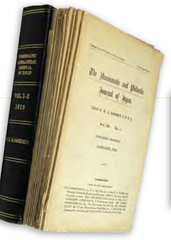 After having fun reading part of the volume they brought to the preview, I attended the first part of the auction and acquired lot 113.
After having fun reading part of the volume they brought to the preview, I attended the first part of the auction and acquired lot 113.
Ramsden, H.A. [editor]. The Numismatic and philatelic journal of japan. Vols. I–IV, lacking only the August 1914 issue for completion. 23 numbers as issued in 21. Yokohama: Jun Kobayagawa, 1913–14. 8vo, first two volumes in later black pebbled cloth, gilt; balance in original printed card covers. Text illustrations throughout, with fine plates, some tinted. Fine.
My budget was helped by having no competition in the room. I didn't take notes, so I hesitate to test my faulty memory by reciting specific lots, but I noted that the American Numisamtic Society acquired a couple of important items (including some of the Clain-Stefanelli material) and that another item went for $32,500, leading to a few shaking heads at the extravagance of it all; the estimate, though 4 figures, was much lower.
Unfortunately, I'd taken time off from work to attend, so I rushed off well before the end of the auction. (Yes, I'd engineered the timing of my work trip in part so that I could spend some time at NYINC, but nonetheless, there was dead communications equipment to be poked at elsewhere in Manhattan.)
To read the earlier E-Sylum article, see: KOLBE & FANNING’S 2013 NEW YORK BOOK SALE A SUCCESS (ww.coinbooks.org/esylum_v16n02a02.html)
THE 2009 CALIFORNIA TREASURY WARRANTS
Last week I mentioned the 2009 California Treasury Warrants in a discussion about how the U.S. could use such warrants if Congress doesn’t raise the debt ceiling. I noted that we hadn't seen an image of one of these warrants yet.
David Klinger writes:
When California sent out IOU slips (warrants) instead of checks for income tax refunds in 2009 (for tax year 2007), many ended up getting one in the mail. Here is a redacted scan of one:

Are you still holding a registered warrant (IOU) issued by the State in 2009?
State of California registered warrants (IOUs) issued in 2009 continue to be redeemed.
The State issued 450,000 IOUs worth $2.6 billion between July 2, 2009, and Sept. 4, 2009, when the IOUs matured.
A registered warrant is a “promise to pay,” or an IOU, that is issued by the State when there are not enough funds to pay all of its General Fund obligations. Registered warrants bear interest and are redeemable by the State Treasury only when the General Fund has sufficient money.
For more information, see: Frequently Asked Questions about Registered Warrants (IOUs) Issued by the State in 2009 (www.sco.ca.gov/eo_registered_warrants_2009_faqs.html)
To read the earlier E-Sylum article, see: COULD THE U.S. GOVERNMENT ISSUE WARRANTS? (www.coinbooks.org/esylum_v16n02a25.html)
QUERY: INDEXES TO COIN WORLD AND NUMISMATIC SCRAPBOOK SOUGHT
In addition to Russ Rulau's work on Hard Times tokens, Embossed tokens, Latin American tokens, and U.S. tokens in general before 1900, Russ also compiled two series of listings which were published in Numismatic Scrapbook magazine, one on the numismatics of Alabama (tokens, medals and paper money) and another on the numismatics of Ohio. There is an index to NSM, but it was published in 1964, so it doesn't cover the issues published from 1965 through 1976.
Over the years there have been some important articles published in Coin World, including many written by Russ Rulau, Bob Julian, and even a couple by myself. But, good luck in trying to find them. Because it was a tabloid, few people saved Coin World, and a full run of them may be a rarity today. In the 1970's, Coin World was available on microfilm, but I don't know how long it continued to be available in this form. The only index to Coin World that I know of is an internal index compiled by the Coin World staff.
To access the Numismatic Indexes Project (NIP), see: nip.money.org
QUERY: UNUSUAL 1811-DATED TOKEN INFORMATION SOUGHT
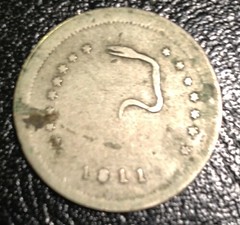
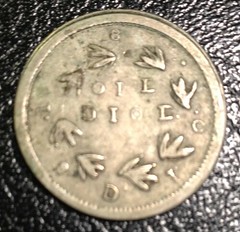
Here's a query for the biggest collective brain trust in numismatics: the E-Sylum readership!
I've enclosed an image of one of the most unusual pieces I've ever acquired, an item that walked up to my table at FUN. The fellow who brought it to me asked what it was, to which I confessed I had absolutely no idea but that I found it interesting. I made him a fairly moderate offer, after which he frowned but admitted the most he'd been offered for it so far was $50. He left the table, but returned the next day and sold it to me. Noted E-Sylum contributor Alan Weinberg was at the table, looked at the piece, and told me I had really "stepped up" by paying such a strong price for something that was so entirely mysterious.
Getting home, I lucked into a lot description in one of my favorite and most oft-used catalogues: the 1914 George Parsons sale by Henry Chapman, which happened to be sitting on my desk:
2077a. Unknown origin. 1811. Snake and 15 stars. R. Eight separate triple leaves, enclosing OIE DIOE, outside .1.0. 8 *0. I D S. Feuchtwanger metal. Size of a dime. Good. Have never met with another — though bearing date of 1811, I take it to be of 1835-1840 work.
My copy has no PRL, so I'm not sure how much it brought. It was the final lot among the Parsons Hard Times tokens.
The piece has a regular if crude reeded edge. The workmanship is reminiscent of circulating counterfeit one real coins of the era, including a piece in my collection dated 1811, though clearly OIE DIOE and the wreath is suggestive of a dime denomination.
Has anyone else ever encountered one, or a reference to one?
QUERY: WASHINGTON-LIBERTY BELL CENTENNIAL MEDAL INFO SOUGHT
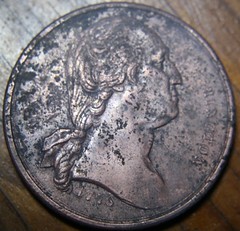
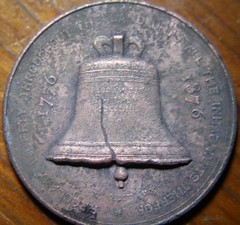
Ron Abler writes:
Yes, it is a Centennial medal. It appears to be a white metal version of HK 32a. If so, it is the first I’ve seen in that alloy.
I don’t think it is listed in Rulau-Fuld, but it is a mule of the obverse of Baker 404 and the reverse of Baker 397. Holland incorrectly describes the obverse die in his number 38 by saying that the date in truncation under the bust is “1876,” when it is obviously 1776. Frossard describes the obverse correctly in his number 314, but neither author lists this particular mule. I do not own this medal in either bronze or white metal, but for illustration purposes I have included the obverse and reverse from the separate medals, below.
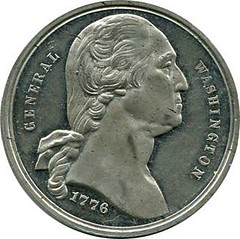
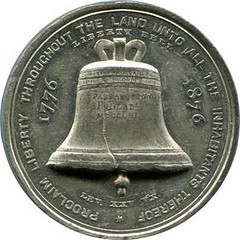
Ron adds:
22.2 grams is spot on for a white metal version. That’s good for me because I knew of it only in bronze. My bronze pieces (different mules, same dies, weigh in at 26.5 to 32.0 grams. Kind of hard to expect a bronze piece to come in as low as 22.2, when my white metal pieces (again, same dies, different mules) range from 18.2 to 22.2 grams.
THE BOOK BAZARRE
HARVEY STACK REMEMBERS HAROLD BAREFORD (PART II)
 What set Harold apart from most other collectors of that time were four “Rules” he formulated early.
What set Harold apart from most other collectors of that time were four “Rules” he formulated early.
First and most important, he bought only the very best condition coins he could find. Many of today’s collectors who style themselves “condition freaks” were decades behind Harold in appreciating quality. In 1947 he described the kind of collection he was assembling to Paul Seitz in the following terms:
“I acknowledge receipt of your Mail Auction Catalogue of May 7th, 1947, and am interested in a few items… Perhaps a word about myself is in order. I collect only the finest specimens… and am not interested in any coin that is not perfect… I am enclosing herewith bids on a few of the coins based on the assumption that they are exactly that. If they have scratches of oxidation, which affects the appearance, on the face of the coin, or in any way are not perfect coins, I wish you to cross out my bid on such coins. To me a perfect brilliant proof… has no defects of any kind whatsoever, the same as gem uncirculated.”
Secondly, he tried to buy the rarest coins first.
Thirdly, he never knowingly bought duplicates and he would never buy an inferior coin hoping to get a better one later.
And fourth, he would never overpay for a coin. He would always work out ahead of time what he thought he should pay and would not exceed this price at auction.
The best examples of how these rules worked were three coins Harold never owned. He never bought a 1796 quarter. Though many Gem Uncirculated coins were sold in this period, none ever had the eagle’s head on the reverse with a full eye visible. He said there had to be a better one fully struck up somewhere and he was going to wait for it. The second example was the 1802 half dime. He knew that F.C.C. Boyd owned the finest he had ever seen and when it was not sold in the World’s Greatest Collection sale, he asked Fred and received assurance that he could have first choice when and if. That coin has never been found and Harold would not buy an inferior substitute.
The last was the 1822 half eagle. C.M. Williams had bought this coin at the Dunham sale in 1941 and had authorized Abe Kosoff to sell it privately in 1950. Kosoff set the half eagle to Harold on approval. Instead of the usual day or two to study a coin, Harold spent over 10 days on this one. Each night after dinner he would get out the eight early half eagles he already owned, take them out of the envelopes and arrange them on felt. He would then add the 1822. He would study them for hours, then put them all back in the safe and repeat the whole thing the next day. Finally, with much reluctance, he sent the coin back to Kosoff. Even though it was the best obtainable, the condition was not good enough and he would not compromise on this principle.
Harold was very proud of his whole collection and particularly so of many of the individual pieces and series in it. He tried for completeness in only two series, half dimes and dimes. Although the collections were missing a few pieces, they were clearly the finest collections ever assembled. But he was most proud of his Dexter 1804 silver dollar. It was probably a goal of every major collector (and dealer for that matter) to own an 1804 dollar and for a perfect Proof to appear privately at just the right time was rare luck, since it precluded the need of having to bid on it and going over his limit.
Harold Bareford essentially stopped U.S. silver coins after 1955. He just couldn’t bring himself to pay more for common date coins than he had paid for the rarities he had purchased earlier. As laughable as it seems now, he was priced out of the market.
So he turned his attention to English coins, particularly collecting English silver pennies by ruler, with special emphasis on the coins of Charles I.
To read the complete article, see: Remember When: Harold Shaw Bareford, A Legendary Collector (stacksbowers.com/Blogs/remember-when-harold-shaw-bareford_18.html)
To read the earlier E-Sylum article, see: HARVEY STACK REMEMBERS HAROLD BAREFORD (www.coinbooks.org/esylum_v15n08a16.html)
ADDITIONAL LABOR EXCHANGE NOTES

Labor Exchange branch #1, Kansas City, MO 1898
Steve Whitfield forwarded the above image of a note from branch #1 of G. B. Bernadi's Labor Exchange system. He writes:
I first saw the note 25 years ago, but I wasn't interested at the time. The note ended up in the Schingothe holdings and was auctioned in the Schingothe 6th sale. It was lotted in a small group of Missouri Scrip. By then I had done a lot of research on G. B. Bernadi and his Labor Exchange System. So, I bid on the note and was lucky to win because it's on the first Branch of more than 300 Branches in 35 states as currently known. More Branches are still turning up. I am waiting for the one on Canada.
I added a Labor Exchange note to my collection this week. It's from branch #183, Marshall, MO. I was interested in it because it's from Missouri, the home state of the labor exchange movement. But I was happily surprised when it arrived, for it turned out to be a type I didn't have. Although the design is SIMILAR to another type, the SIZE is also different - it's larger. Below is an image I scanned of it together with one from Branch #156 (Denver, CO). The Denver note measures 5 1/4" x 2 1/4". (It's from the Stack's John Ford sale 20, lot 3086). My new note is from Branch #183 and measures 6 1/4" by 2 3/4".
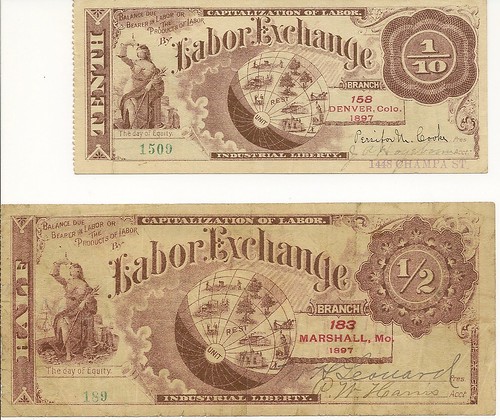
And here's something I'd even forgotten I had. It's not a Labor Exchange note, but a piece of related ephemera - the Labor Exchange Association Obligation of Members, a document to be filled in and signed by new members and witnessed.
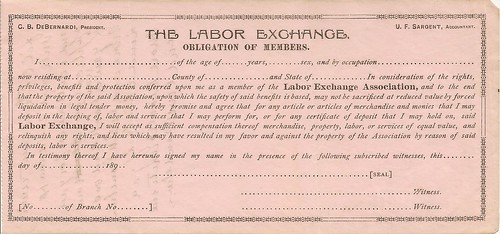
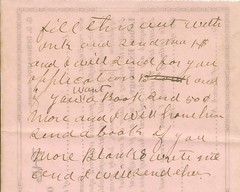 This certificate isn't filled out, but it has handwriting on the back with instructions for the recipient, who apparently thought better of the whole idea. Luckily, thanks to their decision, this item survived.
This certificate isn't filled out, but it has handwriting on the back with instructions for the recipient, who apparently thought better of the whole idea. Luckily, thanks to their decision, this item survived.
To read an earlier E-Sylum article, see:
MORE ON LABOR EXCHANGE NOTES
(www.coinbooks.org/esylum_v15n52a12.html)
WAYNE'S NUMISMATIC DIARY: JANUARY 20, 2013
I had to miss the January Nummis Nova dinner meeting on Tuesday due to an unexpected family matter. Our theme was alternative currencies. I had been planning to bring several items from my collection to show. I'll save most of them for next month, but I put images of some of my Labor Exchange items together with Steve Whitfield's great branch #1 note in the previous article.
But so we can all share in some of the fun, I asked folks to send us images of some of their show-and-tell items. First, a few beauties from David Schenkman.

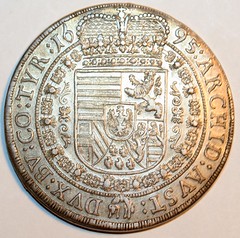 An 1695 Austrian Taler
An 1695 Austrian Taler
Wow - check out that chin! A great condition piece.

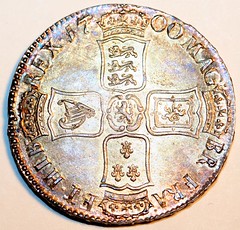
A 1700 Crown
Dave writes:
I bought this 1700 crown at a Stacks sale nearly thirty years ago.

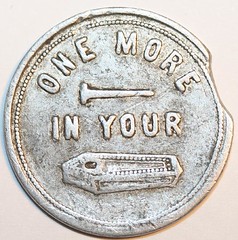 Arizona Nail in Your Coffin Rebus token
Arizona Nail in Your Coffin Rebus token
Dave writes:
This aluminum token came to me in a collection I recently purchased. There were a number of good Arizona tokens, but I like this one because of the rebus reverse. I can’t recall seeing another token with a coffin on it. According to Peter Spooner’s catalog of Arizona tokens, Sam Abraham operated a saloon circa 1894-1914. This token would have been good for a drink.
Well, there are at least two other tokens picturing coffins. We pictured them in the April 15th E-Sylum, from the collection of Eric Schena's wife Heather.
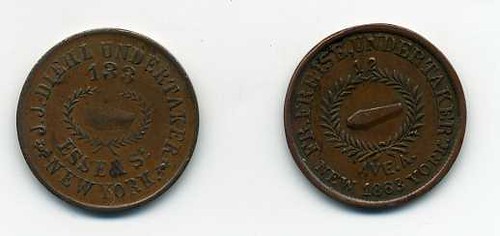
To read the earlier E-Sylum article, see: WAYNE'S NUMISMATIC DIARY: APRIL 15, 2012 (www.coinbooks.org/esylum_v15n16a17.html)
Eric Schena writes:
To go with the night's theme of Alternate Currencies, I brought some examples of Baltimore's BNotes - a local/community currency in circulation at the present. I got them along with a brochure that described their use and where to get them. They are really quite well made and very attractive - it's not apparent in the scans but the serial numbers and the large denomination numeral are in gold. I am still looking for some of the other Mid-Atlantic community currencies (Floyd Hours, Anacostia Hours, and Potomacs) and hope to have some of those to show at a future dinner.
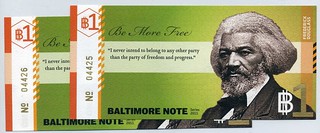
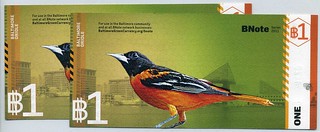
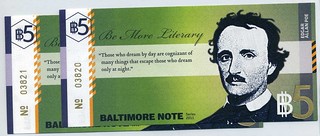
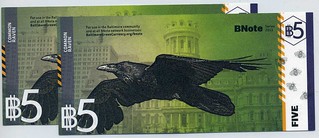
Eric adds:
I also brought an earlier example of a community currency: this time from the Panic of 1907. This note is a $1 note from the Associated Banks of Lynchburg, VA. There are not a lot of examples of Panic scrip from Virginia and, while this is quite low grade, I am pleased to have an example. I also hope to source some Panic of 1893 scrip someday.
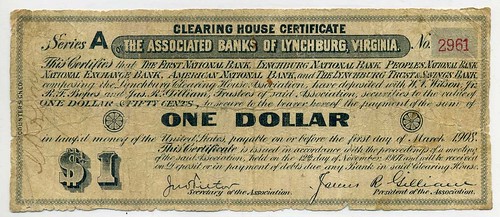
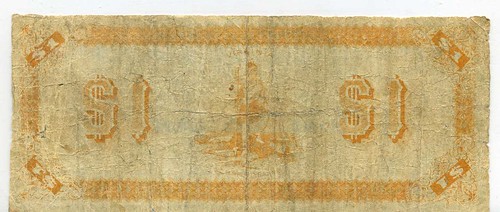
MORE U.S. COINS AT THE BRITISH MUSEUM
Saul writes:
There are many high grade early pieces mostly from the Banks donation which I did not bother to highlight including uncirculated early copper. I leave it for the experts to do the die variety work !!
 1793 Half Cent
1793 Half Cent
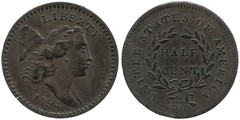 1794 Half Cent
1794 Half Cent
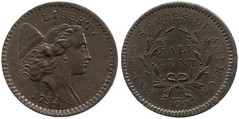 1794 Half Cent
1794 Half Cent
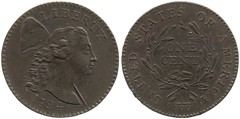 1794 Cent
1794 Cent
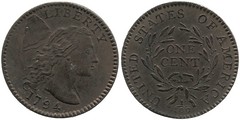 1794 Cent
1794 Cent

To read the earlier E-Sylum article, see: MORE U.S. COINS AT THE BRITISH MUSEUM (www.coinbooks.org/esylum_v16n01a11.html)
1880 $1,000 SILVER CERTIFICATE OF DEPOSIT
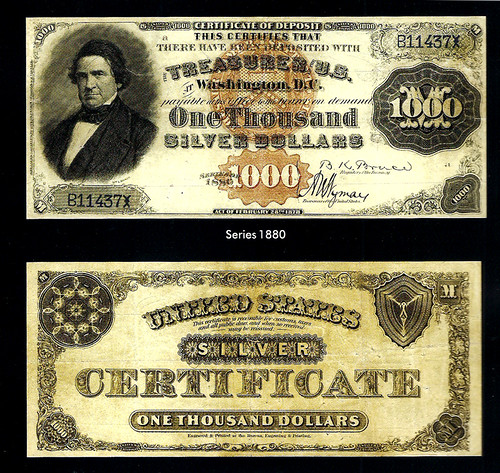
One of only five known, this 1880 $1,000 Silver Certificate of Deposit (Fr. 346d) will be part of a $5 million display 19th century U.S. bank notes at the February 2013 Long Beach Expo. (Photo courtesy of Numismatist Financial Group, Inc.)
THE BOOK BAZARRE
SCULPTOR AMY KANN'S OBAMA-BIDEN 2ND INAUGURAL MEDAL
Rich Jewell writes:
I know a few of you may not be Obama fans but his inaugural medals may be worth a few cents in the coming years. Here's an opportunity to order some medals from a well-known sculptor, Amy Kann, for less than the Inaugural Committee's medals. Amy did the Brookgreen Gardens membership medal in 2010. Check out her KickStarter web page.
 I sculpted this medal celebrating the second inauguration of Obama and Biden, I want to produce an edition of them.
I sculpted this medal celebrating the second inauguration of Obama and Biden, I want to produce an edition of them.
I am a sculptor and I created this Obama/Biden Inauguration medal. I worked very hard to capture the fine man that our president is. It was my intention to capture his intelligence, determination, and humanity. I would like to produce an edition of this medal, but in order to fund that project, I need a minimum order of 25 bronze medals.
Medals are a wonderful way to collect an artist’s work for a small amount of money. It is like owning a tiny fine sculpture of an artist whose work you might want to own. I collect 19th century American and European medals myself for this reason. These inauguration medals can be made in bronze, silver plated bronze, and fine silver.
There are no risks in this project because I have already spent the time making the original and I have a sample from the company that will produce the medal. It is completed and the molds are already made. The rest of the labor is handled by the striking company.
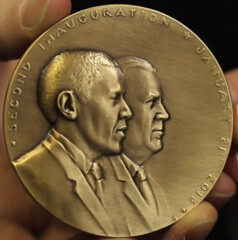
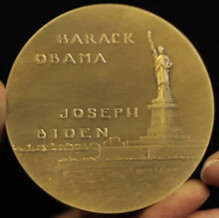
Amy Kann writes:
They are struck at the Medalcraft mint. I was one of the artists asked to compete for the commission and this is what I created. I sculpted the Brookgreen Gardens 2010 Medal. I also sculpted the Eric Newman medal for the American Numismatic Society last year. My website is www.amykann.com.
To read the complete article, see: Obama 2013 Inauguration Medal (www.kickstarter.com/projects/amykann/obama-2013-inauguration-medal)
NATIONAL COLLECTOR’S MINT FINED $750,000 OVER 9/11 "COIN"
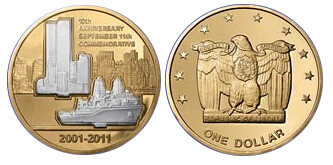
Back in 2010, with the tenth anniversary of the Sept. 11, 2001 attacks on the horizon, Congress authorized the U.S. Mint to produce and sell a commemorative medal. But that didn’t stop one company from advertising imitation versions it called “exclusively authorized” 9/11 commemorative dollar coins.
Thing is, the folks at the National Collector’s Mint hadn’t been given any sort of exclusive authority by the government to make the coins. And though one might not need anyone’s approval to sell a piece of metal commemorating the tragic event, you probably shouldn’t stamp that piece of metal with the words “One Dollar” if you don’t want to tick off the government.
“Congress has the exclusive power to coin money of the United States,” wrote the U.S. Mint in a consumer advisory regarding the imitation coins. “Congress has delegated its authority to mint and issue coins to the Secretary of Treasury, and Congress requires the Secretary to carry out these duties at the United States Mint. Thus, the United States Mint is the only government entity in the United States with the authority to coin money.”
The makers of the coin stated that its product was actually legal tender in the nation of Liberia.
Regardless, the Federal Trade Commission — which has reached a $750,000 settlement with National Collector’s Mint — alleges the company violated the Hobby Protection Act by producing imitations of the U.S. Mint’s medal without marking them “COPY” as the act requires.
Furthermore, claims the FTC, the makers of these coins charged consumers for items they never ordered, and made returning the product difficult — and costly — if not impossible.
To read the complete article, see:
Sellers Of Imitation “Exclusively Authorized” 9/11 Commemorative Coins To Pay $750,000
(consumerist.com/2013/01/17/sellers-of-imitation-exclusively-authorized
-911-commemorative-coins-to-pay-750000/)
The Federal Trade Commission is coming down hard on a company seeking to cash in on phony 9/11 memorabilia.
National Collector's Mint, based out of Port Chester, NY, was advertising a 9/11 commemorative coin that purportedly contained actual silver from ground zero.
In fact, the silver was just an imitation.
The coins featured images from the World Trade Center and the USS New York, a naval ship partially constructed from the steel recovered after the 9/11 attacks.
To read the complete article, see
Company selling 9/11 commemorative coins LIED about silver from the World Trade Center
(www.dailymail.co.uk/news/article-2265317/National-Collectors-Mint
-Company-selling-9-11-commemorative-coins-labeled-scam.html)
ANA SEEKS PAPERS ON WORLD’S FAIR NUMISMATICS
The American Numismatic Association is accepting papers on “Numismatics in its Relationship to World’s Fairs and Expositions" from authors and researchers who would like to be a part of the Maynard Sundman Littleton Coin Company Lecture Series.
Selected authors will be asked to deliver presentations in the Aug. 14 symposium at the ANA World’s Fair of Money in Chicago. This year marks the 120th anniversary of the 1893 World’s Columbian Exposition and the 70th anniversary of the Century of Progress International Exposition, both held in Chicago.
Selected presenters will receive a $250 honorarium. Submissions, which are due April 5, should consist of a lecture summary that is 500 words or less. Each summary should contain an introduction, a brief discussion of the subject, sources and research method.
Priority is given to papers that emphasize areas of new research and scholarship.
Submit applications by mail to: Susan McMillan, Education Project Manager, American Numismatic Association, 818 N. Cascade Ave., Colorado Springs, CO 80903; or by email to mcmillan@money.org. Electronic submissions are preferred but not required.
A panel will review submissions and choose talks based on originality, persuasiveness and relevance to the symposium topic. Presenters will be notified by April 26, 2013.
Proceedings from the symposium will be published on the American Numismatic Association website (www.money.org). Presenters must provide an electronic copy and printout of their papers prior to the symposium.
For more information, contact McMillan at 719-482-9850 or mcmillan@money.org.
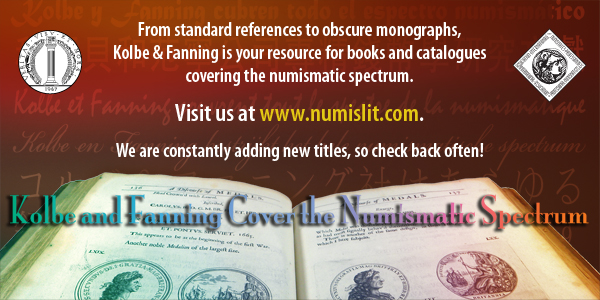
HANS VOGLER'S COIN ROLLING MILL
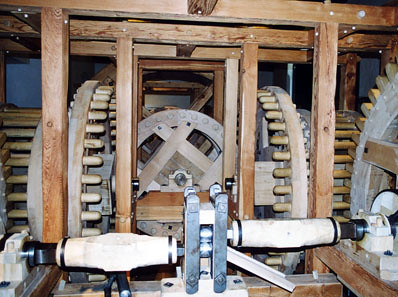
In the summer of 1562, three natives of Zurich teamed up to promote a technology that promised to yield substantial profits, a new rolling mill that allowed the production of better coins in less time with less effort. The partners of this consortium were Jakob Stanpfer, mint master in Zurich since 1561, who already made good use of this new minting machine, Rudolf Rordorf, an engineer who was engaged in the construction of rolling mills, Martin Rosentaler, another minting technician, Jakob Bluntschli, a carpenter – after all, the most important material of roller minting presses was wood – and Hans Vogler the Younger.
Most likely every member of this consortium realized how important it was to present their own machine to the princes in a proper way – you see, the men from Zurich weren’t the only ones who had built a rolling mill. After the rack had gained currency in the second quarter of the 16th century, it was but a small step to the rolling mill. From the middle of the 16th century onwards, several so-called mint artists appeared on the scene who presented the European royal courts new machines for coining. They were all based on the rolling mill principle: a long metal strip ran through two rollers that ‘minted’ the strip with images on both sides. This new technology’s difficulty was in the detail: how to produce enough pressure needed to achieve the proper minting depth? How to cut the dies needed to achieve a circular imprint? How to make the upper roller run at exactly the same pace as the one for the reverse?
Jakob Stampfer had solved most of these problems to a greater or lesser extent. Admittedly, when Ferdinand I, German emperor reigning between 1556 and 1564, provided him with the opportunity to present his minting machine, the ones responsible judged his technology as not yet mature because the machine needed considerable maintenance and reparations on a daily basis. Consequently, the emperor didn’t contract Stampfer but Rudolf Rordorf for installing a rolling mill although the latter hadn’t sampled his skills yet. That was probably the reason for a quarrel between Rordorf and Stampfer which became a matter for the Zurich Council in 1564. Stampfer and his sons had to manage all by themselves, since the other members of the rather short-lived ‘minting consortium’ likewise filed a suit against the mint master from Zurich.
These conflicts needn’t concern us here, though. Let us turn to Rordorf and his rolling mill instead, which he promised the inhabitants of Tyrol to build. The cautious emperor had negotiated a contract with Rordorf that guaranteed the latter a reward of 1,500 gulden in case he successfully built and installed two minting machines. Exact numbers were laid down as to their projected mintage. The plan was that eight assistant would be able to mint 1,500 mark silver per week with the new machines. If only large-size silver coins were minted, that would have been more than 15,000 specimens, a huge number! But Rordorf’s promises turned out to be too optimistic.
To read the complete article, see:
The People of Zurich and their Money 8: a technology from Zurich captures the world
(www.coinsweekly.com/en/The-People-of-Zurich-and-their-Money
-8-a-technology-from-Zurich-captures-the-world/8?&id=258&type=a)
COUNTERFEIT BANKNOTES CIRCULATE FREELY IN CUBA
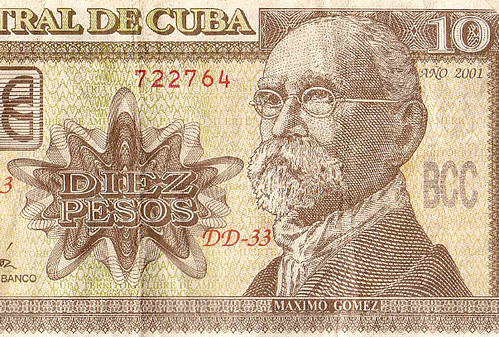
Fake banknotes are circulating in the Cuban capital Havana, but although they are fairly easy to spot, residents pass them from hand to hand with apparent unconcern.
“No one bothers to check whether a banknote is fake,” taxi driver Rafael García said. “Just as I will accept it, I’ll hand it back to [other] customers.”
García said he had no idea where the banknotes came from, adding that the police did not seem to be doing anything about it.
There have been no official announcements about the counterfeit notes, which come in ten- and 20-peso denominations.
The fakes are easy to identify on inspection – the ten-peso notes are the right colour, but are missing a watermark depicting Cuban revolutionary Celia Sánchez. The 20-pesos are watermarked with the correct image of Camilo Cienfuegos, another revolutionary hero, but are greener than the blue of the originals, and the colour runs.
Havana resident Michel López warns, “The day people run into legal trouble is the day they’ll start having to take the use of counterfeit money seriously.”
To read the complete article, see: Fake Banknotes in Havana (iwpr.net/report-news/fake-banknotes-havana)
AUSTRALIAN MAN FINDS MASSIVE GOLD NUGGET
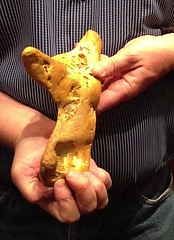 An amateur prospector has discovered a once-in-a-lifetime find in the most unlikely of places - finding a huge lump of gold worth £200,000 in the Australian bush.
An amateur prospector has discovered a once-in-a-lifetime find in the most unlikely of places - finding a huge lump of gold worth £200,000 in the Australian bush.
Using only a handheld detector, the unnamed novice was amazed when he found the y-shaped nugget 60cm underground near the town of Ballarat in Victoria.
Weighing 5.5kg, the discovery has delighted local experts who say that they have never encountered such a significant find.
The prospector was using a state-of-the-art detector, allowing him to locate the 'extremely rare' nugget in previously searched ground.
But despite the enormity of the find, the man initially thought he had detected 'the bonnet of a car' before seeing a 'glint of gold'.
Perhaps not quite believing his luck, friends revealed how the man kept cleaning the piece and 'the gold kept expanding and expanding'.
Ballarat Mining Exchange Gold Shop owner and dealer Cordell Kent said: 'I have been a prospector and dealer for two decades, and cannot remember the last time a nugget over 100 ounces (2.8kg) has been found locally.'
He said the anonymous prospector is a 'person that really deserves it' revealing that he rushed to tell his wife after finding it.
Gold currently trades in Australia at about $1,600 (£1,050) per ounce but because finding a piece weighing more than a kilogram is so rare this adds a premium.
The nugget measures 220mm in length, is 140mm wide and 45mm at its deepest point.
The trader also expected the find to attract a lot more prospectors to the area, saying: 'A finding like this gives people hope.
'There's nothing like digging up money, it's good fun.'
To read the complete article, see:
Amateur prospector finds 5kg nugget of gold in Australian bush that’s set to sell for £200,000
(www.dailymail.co.uk/news/article-2263873/Amateur-prospector
-finds-5kg-nugget-gold-Australian-bush-s-set-sell-200-000.html)
THE BOOK BAZARRE
MAIL BID SALE # 18 CLOSES SATURDAY FEBRUARY 2, 2013
CATALOGS ARE BEING SENT TO ALL INDIVIDUALS ARE ON OUR
MAILING LIST, AND ON REQUEST AT NO CHARGE. THE CATALOG
IS ALSO VIEWABLE ON OUR WEB SITE.
BIDDERS MAY ENTER THEIR BIDS BY MAIL, TELEPHONE, EMAIL OR FAX.
DAVID SKLOW – FINE NUMISMATIC BOOKS
P.O. BOX 6321
COLORADO SPRINGS, CO 80934
TEL: (719) 302-5686
FAX: (719) 302-4933
numismaticbooks@aol.com
www.finenumismaticbooks.com.
AMERICA'S FIRST BOOKLESS PUBLIC LIBRARY
 Apple's simplistic design scheme for its Apple Stores has inspired the look of several other retail stores, most notably, Microsoft's.
Apple's simplistic design scheme for its Apple Stores has inspired the look of several other retail stores, most notably, Microsoft's.
But come this fall, people in Bexar County, Texas will soon have an Apple Store-like experience in bookless libraries.
That's all thanks to Bexar County Judge Nelson Wolff, who was inspired to create bookless libraries throughout the county while reading Walter Isaacson's biography of Steve Jobs.
"If you want to get an idea what it looks like, go into an Apple store," Wolff told the San Antonio Express News.
The first bookless library, called BiblioTech, will be a test and is set to open in the fall on the south side of the county. But these bookless libraries will not replace the current system. Instead, Wolff says, they are meant to enhance them.
To read the complete article, see:
How Apple Inspired The Design Of America's First Bookless Public Library
(www.businessinsider.com/how-apple-inspired-the-design-of
-americas-first-bookless-public-library-2013-1)
PERTH MINT COIN DESIGNER ING ING JONG
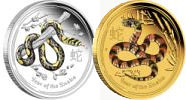 The designs of the latest Australian Lunar coins from The Perth Mint are the work of talented illustrator Ing Ing Jong.
The designs of the latest Australian Lunar coins from The Perth Mint are the work of talented illustrator Ing Ing Jong.
Ing graduated from Perth’s Central TAFE School of Art and Design in 2006 with an Advanced Diploma in Graphic Design, having specialized in illustration and multimedia. She promptly enrolled for a Bachelor of Multimedia at Curtin University in order to undertake advanced studies in animation, web design, illustration and video editing.
As somebody who loves to draw and create her own characters, one of Ing’s biggest inspirations is Disney
“I have long admired how Disney animators are able to convey the essence of the character’s emotions through their sketches… I decided to study both graphic design and multimedia to add to my portfolio and learn more about the craft that I love.”
Her flair and dedication paid off in 2011 with an invitation to join The Perth Mint as a coin designer.
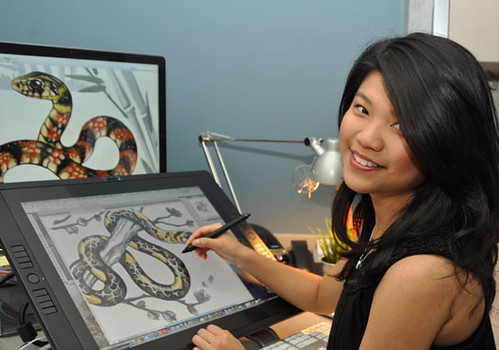
After several successful projects, Ing was asked to design the 2013 Lunar series. Feeling both excited and intrigued, she headed to a local zoo for some genuine ‘hands on’ research – and was delighted to be given the chance to handle a large python! “I was surprised by how silky it felt to touch and how calm it behaved,” she said.
“I reflected my experience by portraying the patience and charming nature of the snake. I particularly enjoyed showing the calmness and control of the animal. The design best reflects a traditional Chinese style of painting where the snake blends in to its natural environment.”
To read the complete article, see: Ing brings Snakes to life on Lunar coins (blog.perthmint.com.au/2013/01/15/ing-brings-snakes-to-life-on-lunar-coins/)
IS THE MAPLE LEAF ON CANADIAN BANKNOTE NORWEGIAN?
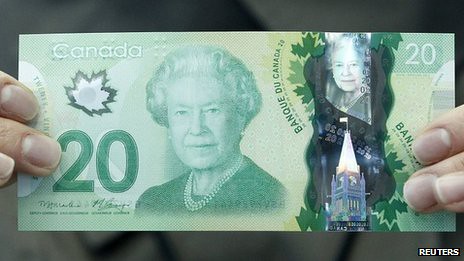
Canada's new plastic banknotes feature Norwegian maple leaves, instead of the Canadian sugar maple leaf, according to botanists.
They argue the leaf shown features more sections and has a more pointed outline than the Canadian version.
The maple leaf is featured on the new C$20 (£13), C$50 and C$100 notes, which were introduced in November.
Bank of Canada officials say the image is a "stylised" leaf, created with the help of a botanist.
"I think it's just an after-the-fact excuse," said Sean Blaney, senior botanist at the Atlantic Canada Conservation Data Centre, who first brought the image to the attention of the broadcaster CBC.
The Norway maple, however, is a popular tree in central and eastern Canada, after being imported from Europe.
"It has naturalised to Canada," Mr Blaney said.
"This could not be confused with a native species of Canada," Julian Starr, a botany professor at the University of Ottawa, told the CBC.
In August, the Bank of Canada apologised for removing an image of an "Asian-looking" woman from the design of the new $100 bank note.
The polymer banknotes have also faced criticism for not working in many vending machines
To read the complete article, see: 'Wrong' maple leaf on Canadian banknote (www.bbc.co.uk/news/world-us-canada-21093230)
PAKISTAN RUMOR CAUSES RUSH TO BUY OLD ONE RUPEE COINS
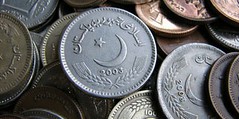 Thousands of old one-rupee coins were sold for millions of rupees in the Makran, Balochistan, on Tuesday in what became a ‘gold rush’ in the area, The News International, Pakistan’s leading English language newspaper reported on Wednesday.
Thousands of old one-rupee coins were sold for millions of rupees in the Makran, Balochistan, on Tuesday in what became a ‘gold rush’ in the area, The News International, Pakistan’s leading English language newspaper reported on Wednesday.
It said throughout the day, people spent their time looking for the humble golden-coloured coin which was being sold for as much as Rs1,000 in some cases — though no one quite knew why.
The paper said It was rumoured later in the day that it was being smuggled to Iran which was buying it because “it contained uranium”. Regardless of whether or not there was any truth in the story, the frenzy persisted all day.
“I had heard another rumour in the morning that jewellers are buying it because it’s full of gold,” The News quoted a beggar Murad Baloch as saying. “I don’t care about rumours. I sold 150 for Rs45,000 and bought myself a new motorbike.” He thinks he has earned it for he has been begging for coins all his life.
It said the news of the coin’s value spread in the Turbat bazaar thanks to beggars like Murad and drug addicts, who had compromised on their usual rate of not taking anything less than five rupees and were insistent on being given one rupee and only one rupee. And when people came to know of the price of the currency, its rates started skyrocketing.
To read the complete article, see:
Old One Rupee Coins Sold For Millions Of Rupees In Balochistan Report
(www.thenewstribe.com/2012/06/06/old-one-rupee-coins-sold-for-millions
-of-rupees-in-balochistan-report/)
This is an amusing story from Pakistan. A rumour has taken hold that the old 1 rupee coin is worth substantially more than the 1 rupee face value due to the metal content. Thus people are purchasing them at higher than face value and then trying to pass them along.
What amuses me about the story is that it is in fact true that the coins are worth higher than face value: but for very different reasons than those that are floating around. Indeed, I can see a plausible explanation for how the whole rumour started.
I can imagine some likely lads putting 2 and 2 together and deciding to try and collect as many of the old 1 Rs coins as they can. This hoarding, or even the attempt to hoard, becomes known and then the rumour takes off. The value is vastly higher than the mere doubling that is actually possible. For we do know that markets are subject to these sorts of booms, bubbles and even mass delusions. Most especially in societies where gossip, the grapevine, is the primary method by which news spreads.
Looking around various Pakistani message boards there are quite a number of people offering such 1 Rs coins for 100 Rs and more. Which means that an awful lot of people are going to be disappointed when the truth comes out.
To read the complete article, see: The Pakistani 1 Rupee Coin Is Worth More Than 1 Rs (www.forbes.com/sites/timworstall/2012/06/13/the-pakistani-1-rupee-coin-is-worth-more-than-1-rs/)
FEATURED WEB PAGE: ORIGINAL HOBO NICKEL SOCIETY
This week's Featured Web Page is the Original Hobo Nickel Society (OHNS).

www.hobonickels.org

